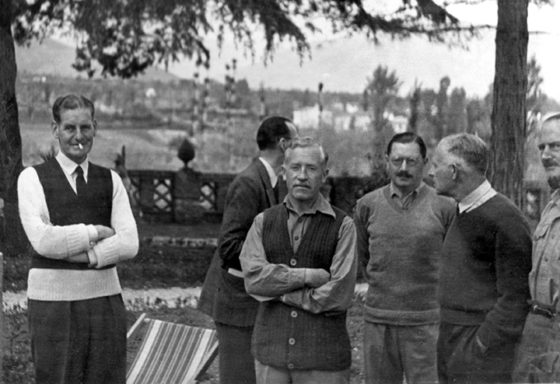
“Doughnuts would not be popular in America today if not for the efforts of the Salvation Army and the nation’s entry into the First World War.”
By George Yagi Jr.
IN THE SUMMER of 1917, the first U.S. troops landed in France. Accompanying them was a contingent of volunteers from another, much smaller army – the Salvation Army.
All told, 250 young women joined the charity to travel with the American Expeditionary Forces (AEF) to Europe. The organization’s 52-year-old firebrand matron, Evangeline Booth, tenaciously lobbied a reluctant U.S. General John Pershing to allow her volunteers to provide aid and support to the soldiers at the front. Eventually, he agreed.
Each member of Booth’s brigade carried a helmet, a gas mask and a .45 caliber revolver. The women soon found themselves in the trenches where they would serve as nurses, relief workers, and, most famously, as “Doughnut Girls.”
Amazingly, this celebrated nickname came about by pure happenstance, thanks to a pair of Booth’s volunteers — Ensigns Helen Purviance and Margaret Sheldon.
The two were stationed with U.S troops at Montiers-sur-Saulx in October of 1917. The soldiers manning the lines there had endured 36 days of constant rain. As morale plummeted, Purviance and Sheldon figured that some tasty baked goods would lift everyone’s spirits. After looking over the meager supplies available, the young women decided to try to make a batch of doughnuts. At the time, the now-ubiquitous fried-dough snack was available in some stateside cities, but it was still largely unknown to most Americans.
With a blanket concealing their kitchen from prying eyes, the two ensigns went to work. Equipped with only a very small pot-bellied stove, Purviance later recalled, “I was literally on my knees when those first doughnuts were fried, seven at a time, in a small frypan.”
Continuing their work into the early morning hours, the pair eventually whipped up 150 doughnuts. They were an instant hit. The first soldier to receive one of the sweet treats was Private Braxton Zuber.
“Oh, boy!” he reportedly exclaimed. “If this is war, let it continue.”
The following day, Purviance and Sheldon, made a fresh batch of doughnuts – 300 this time. All were devoured by grateful infantrymen. Word quickly spread and soldiers up and down the line were clamoring for more of the fried treats. Eventually, Purviance would find herself making as many as 8,000 doughnuts a day.

With little in the way of kitchen supplies, the women were forced to improvise. Wine bottles and shell casings were used as rolling pins, baking soda tins became cutters, and some doughnuts were even fried in soldiers’ helmets. When Purviance made her first batch of doughnuts, they were simply twisted bits of dough that had been cut with a knife. Soon requests arose for a doughnut with a hole, so Purviance approached an elderly French blacksmith for help making a specialized cutter. She gave him a condensed milk tin and a shaving cream tube to create the necessary utensil.
“He couldn’t speak any English and I couldn’t speak any French, but somehow I managed to get him to understand that I wanted these two things nailed together on a small block of wood,” she recalled. “This served as our doughnut cutter for more than a month until a real one was sent over from the United States.”
Soon, Salvation Army volunteers all over the Western Front were making doughnuts. And as the war continued, the doughnut-making operations became ever more complex. Lieutenant Alice McAllister later recalled of her arrival at a Salvation Army outpost at Saint-Nazaire:
We arrived and found Adjutant and Mrs. Hickey in charge there. There was a huge canteen and a large aeroplane hanger for meetings and entertainment. There were a dozen or more girls there – part working in the canteen and the rest of us making doughnuts. We made them every day by the thousands and gave them away in the afternoon with hot chocolate.
The workload was exhausting, especially for the volunteers working in smaller groups on the front.
“Well can you think of two women cooking, in one day, 2,500 doughnuts, eight dozen cupcakes, fifty pies, 800 pancakes, and 255 gallons of cocoa, and one other girl serving it,” Purviance said “That is a day’s work.”
Doughnuts quickly became a small, but indispensable luxury for American troops in France. In fact, the U.S. soldiers’ famous nick-name “Doughboys” may very well be a byproduct of the work of the Salvation Army volunteers.
While some maintain that the name references the large buttons on U.S. Army uniforms of the era, which resembled globs of dough, others say that the expression originated among British Tommies who marveled at the Americans’ insatiable appetite for doughnuts.

Following the end of the First World War, demand for the doughnut did not go away. With the return of thousands of veterans from France, the treats began appearing in bakeries and other public places. In the coming years, Doughnuts would become an American staple.
In 1938, just 20 years after the signing of the Armistice, a fundraiser was held by the Chicago Salvation Army to help those suffering from the Great Depression and also to honor the brave women who had served doughnuts during the war. Following the gathering, National Doughnut Day was born. It’s celebrated annually to this day on the first Friday of June. While the doughboys and doughnut girls have long passed, their sweet legacy remains alive and well. In fact, doughnuts would not be popular in America today if not for the efforts of the Salvation Army and the nation’s entry into the First World War.
Dr. George Yagi Jr. is an award winning author and historian at the University of the Pacific. Follow him on Twitter @gyagi_jr.










1 thought on “Doughboys and Doughnut Girls – How the Salvation Army’s WW1 Women Volunteers Made History, One Tasty Treat at a Time”